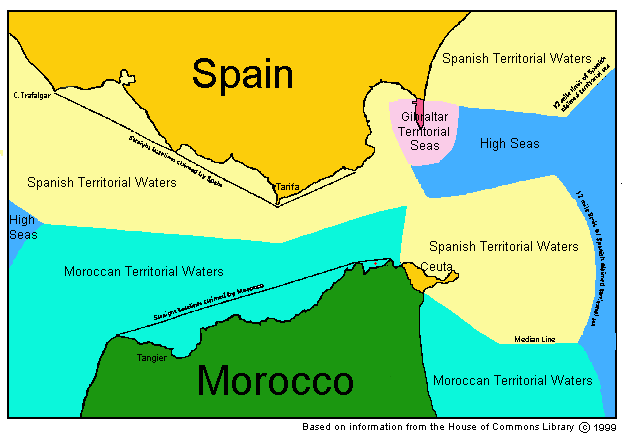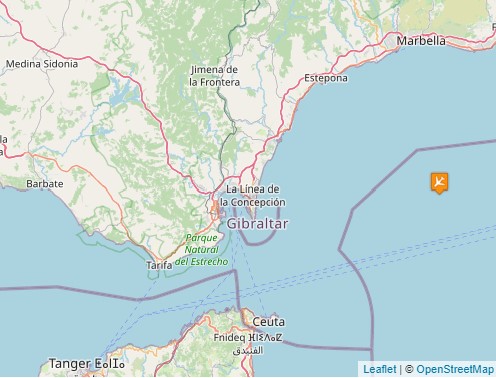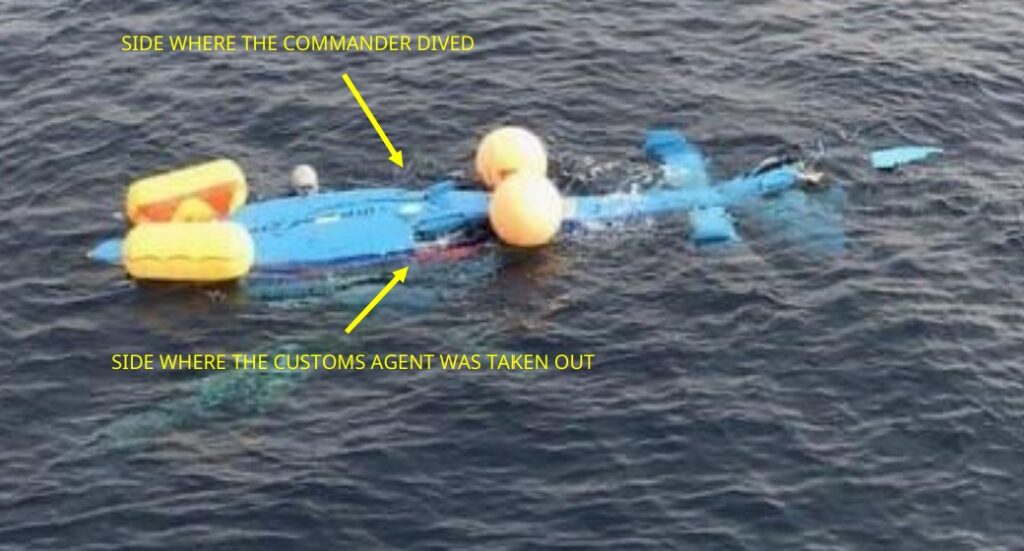Blinded by Light, Spanish Customs AS365 Crashed During Night-time Hot Pursuit (Eliance/SVA Airbus AS365N3 EC-JDQ)
On 11 July 2021 Airbus AS365N3 EC-JDQ, operated by Eliance for the Spanish Customs Surveillance Service (Servicio de Vigilancia Aduanera [SVA]) impacted the sea while manoeuvring in pursuit of a smuggler’s boat. The two Fight Crew survived but a Customs Agent was died, having been trapped in the capsized helicopter.

Salvaged Wreckage of Eliance/SVA Airbus AS365N3 EC-JDQ (Credit: CIAIAC)
The Accident
In the safety investigation by the Spanish the Civil Aviation Accident and Incident Investigation Commission (CIAIAC), issued in Spanish in December 2022, the investigators explain that the helicopter left its base at Algeciras, Cadiz at 01:20 for a routine patrol. The Straits of Gibraltar are notorious route for drug smuggling from North Africa.

The Aircraft Commander (9,347 hours experience, 4,005 on type and c7,000 hours flying customs flights) was the Pilot Flying (PF). The Co-Pilot (5,935 hours, though only 14.5 on type having joined the operator 2 months earlier with a SAR & HEMS background) was the Pilot Monitoring (PM). The Customs Agent was in the cabin, in the front left seat, at a FLIR equipped work station. The aircraft was operating Night VFR rules. The investigation report makes no mention of Night Vision Imaging Systems (NVIS) googles being used.
When they took off, the pilot at the controls the PF set their radalt bug to 300 ft and the other PM had theirs set to 500 ft.
When descending below 500 ft the PM would re-set theirs to 100 ft.

Eliance/SVA Airbus AS365N3 EC-JDQ in July 2015 (Credit: Bene Riobó CC BY-SA 4.0)
When they had been flying for approximately five minutes, they heard on the radio that an SVA vessel (Patrol Boat Águila 4 [a 17 m, 50 knot, Rodman 55]), based in the Port of Algeciras, was pursuing a boat and the Customs Agent offered to support them from the air in the chase.
The crew of the Patrol Boat answered in the affirmative and provided them with their coordinates.
The helicopter crew verified that the Patrol Boat was at a distance of approximately 35 NM to the east and began to move towards the area where the pursuit was taking place.
The smugglers were taking a longer route to Spain. Which also meant operating further from cultural (i.e. man-made) lighting ashore.

When they were south of Europa Point [site of the Trinity House lighthouse at the southern tip of Gibraltar], heading towards the coordinate point they had been given, they gradually descended from an altitude of 3,500 ft, until they reached the vicinity of the vessels, flying with 70% torque and a speed of 130 kt…

When in pursuit of a vessel, the flight crew would turn on the landing lights. These were deployed but not turned on at this point. When slowing below 80 knots the PM armed the emergency flotation system. Crucially:
There was a lot of humidity and scattered banks of fog…according to a statement from the PF.
When the Customs Agent located the two vessels, using the FLIR surveillance system, he guided the crew with more precision until they positioned themselves close to them.
When positioned to the left of the SVA patrol boat they descended “very rapidly” from an altitude of 500 ft to below 100 ft. There is no discussion on the use of any automation, the implication being that the descent was conducted manually. It can be presumed that customs flights have a low flying exception (though the CIAIAC don’t elaborate).
As they descended below 200 ft the flight crew turned the landing lights on. The illumination resulted in glare from the humidity in the air which mean the flight crew lost sight of the vessels and the surface. Shortly after the crew “felt a jolt” as the tail contacted the sea. Wind speed was c30 knots, wave height c 1 m and sea temperature was 22°.
The cabin was then submerged and the helicopter flipped over to the right side. The FLIR video recording showed how the aircraft entered the water at 1:44:12. As the helicopter entered the water the Aircraft Commander activated the floats.
The helicopter floated inverted. All three occupants had undertaken Helicopter Underwater Escape Training (HUET).
The occupants of the helicopter do not appear to have been equipped with a Compressed Air – Emergency Breathing System (CA-EBS). All were wearing lifejackets. Only the Aircraft Commander was wearing a helmet.
The two Flight Crew members each left the aircraft through the door on their side and swam until they reached the surface.
The Aircraft Commander swam around the nose to the Co-pilot. They realised the Customs Agent had not surfaced so both swan underwater to try to locate and rescue him.
The helicopter had a manually deployed cabin mounted internal life raft. This was not deployed.
Patrol Boat Águila 4 abandoned the pursuit immediately the helicopter crashed, radioed a mayday at 01:45 and went to the aid of the occupants of the helicopter. Two of the vessel’s crew dived into the water too.
The Aircraft Commander had difficulty diving because his lifejacket and helmet prevented him from
submerging, so the two patrol boat officers helped him remove his vest by slitting it with a knife and
also helped him remove his helmet.When the Commander submerged again and opened a helicopter door, he came across a package that turned out to be a backpack carried by the Customs Agent.
After several attempts the rescuers located the Customs Agent in the cabin and brought him to the
surface (this was radioed at 01:53).

Eliance/SVA Airbus AS365N3 EC-JDQ Floating Inverted In Daylight (Credit: CIAIAC)
The boat took everyone aboard and headed for the Sotogrande marina. The SAR helicopter that had been activated was stood down based on the vessel’s ETA in port. During the journey members of the crew performed cardiopulmonary resuscitation (CPR) on the rescued Customs Agent, who was later pronounced dead in hospital. There was however a delay ensuring a ground ambulance met the vessel in port.
The CIAIAC Safety Investigation
The helicopter did not carry cockpit voice or flight data recorders, which were not required by regulation.
Examination of GPS data showed the began to descend continuously at 1:36:45, when it was at an altitude of 3,499 ft.
From that moment until the accident occurred at 1:44:12, 7.45 minutes elapsed, during which it descended 3,499 ft. The mean vertical speed was therefore 469.66 ft/min. There are two instants, at 1:41:15 h and 1:45:30 h, in which the vertical speed was 718.84 ft/min and 731.57 ft/min, respectively.
The highest vertical speed occurred 27 s before the accident, at 1:43:45 h, reaching 1,046.84 ft/min.The data extracted from the images of the FLIR infrared tracking system also confirm an excessive average vertical speed in the last moments, above 570 ft/min, and indicate that the difference in headings between the helicopter and the vessel they were chasing.
Later that day the Sociedad de Salvamento y Seguridad Marítima (SASEMAR) 80 m UT722 pollution control vessel Clara Campoamor salvaged the capsized but still floating helicopter.

SESEMAR Clara Campoamor (Credit: Santiago Mena CC BY-SA 3.0)

Salvage of Eliance/SVA Airbus AS365N3 EC-JDQ (Credit: CIAIAC)
The tail was found badly damaged. The Automatically Deployable Emergency Locator Transmitter (ADELT) was missing. There is no mention of it activating or being recovered.

Damaged Tail / Fenestron of Eliance/SVA Airbus AS365N3 EC-JDQ (Credit: CIAIAC)
The autopsy determined that the cause of death [of the Customs Agent] was acute respiratory failure as a consequence of mechanical suffocation by immersion, around 2:00 h.
The investigators found the helicopter operator did not have specific procedures in their Operations Manual for customs operations (which are outside the EASA Basic Regulation). There also appears to have been no oversight by the regulator AESA of operations (only airworthiness and licencing) for customs flights (unlike for other operations outside the EASA BR such as SAR and fire-fighting).
CIAIAC Cause
The investigation has concluded that the cause of the accident was carrying out a sudden manoeuvre at low altitude and with reduced visibility, not contemplated in the Operations Manual.
CIAIAC Recommendations
Two recommendations were made on 14 March 2022 to the operator to enhance their Operations Manual.
Subsequently the operator received a recommendation to provide specific training for crew new to customs operations.
SVA were recommended to define the requirements for customs aviation operations and to ensure that HUET training was conducted by its personnel (noting that the officer who died was in fact HUET trained). The local government of Andalucía were tasked to investigate the delayed ground ambulance arrival.
Our Safety Observations
No specific reason was determined for the Customs Agent’s inability to egress.
There is minimal consideration of the visual effect the crew encountered in the report.
There is also no consideration of the radalt settings and what alerts occured and no comparison with the newly optimised HTAWS offshore modes.
Discussions of the value of having NVIS and CA-EBS would have been useful.
Again this appears to be another case of an ADELT failure, although it is likely to have borne the full force of the initial water impact.
Safety Resources
The European Safety Promotion Network Rotorcraft (ESPN-R) has a helicopter safety discussion group on LinkedIn. You may also find these Aerossurance articles of interest:
- Offshore Night Near Miss: Marine Pilot Transfer Unintended Descent
- A HEMS Helicopter Had a Lucky Escape During a NVIS Approach to its Home Base
- Air Ambulance Helicopter Struck Ground During Go-Around after NVIS Inadvertent IMC Entry
- Automation Issues During Night SAR Training – Near CFIT
- North Sea Helicopter Struck Sea After Loss of Control on Approach During Night Shuttling (S-76A G-BHYB 1983)
- NTSB Investigation into AW139 Bahamas Night Take Off Accident
- Night Offshore Training AS365N3 Accident in India 2015
- Loss of Control, Twice, by Offshore Helicopter off Nova Scotia
- SAR Helicopter Loss of Control at Night: ATSB Report
- US Fatal Night HEMS Accident: Self-Induced Pressure & Inadequate Oversight
- HEMS A109S Night Loss of Control Inflight
- Air Ambulance A109S Spatial Disorientation in Night IMC
- HEMS S-76C+ Night Approach LOC-I Incident
- Night Offshore Windfarm HEMS Winch Training CFIT (BK117C1 D-HDRJ)
- TCM’s Fall from SAR AW139 Doorway While Commencing Night Hoist Training
- Swedish SAR AW139 Damaged in Aborted Take-off Training Exercise
- Fatal Taiwanese Night SAR Hoist Mission (NASC AS365N3 NA-106)
- SAR Crew With High Workload Land Wheels Up on Beach
- Beware Last Minute Changes in Plan
- NH90 Caribbean Loss of Control – Inflight, Water Impact and Survivability Issues
- SAR AW101 Roll-Over: Entry Into Service Involved “Persistently Elevated and Confusing Operational Risk”
- Night Mountain Rescue Hoist Training Fatal CFIT
- Heliski Flat Light Flight into Terrain
- Canadian Flat Light CFIT
- That Others May Live – Inadvertent IMC & The Value of Flight Data Monitoring
- UPDATE 8 July 2023: BK117 Offshore Medevac CFIT & Survivability Issues
- UPDATE 16 July 2023: SAR AW139 LOC-I During Positioning Flight
- UPDATE 13 July 2024: Fatal USCG SAR Training Flight: Inadvertent IMC
- UPDATE 20 July 2024: Night CHC HEMS BK117 Loss of Control
The Tender Trap: SAR and Medevac Contract Design Aerossurance’s Andy Evans discusses how to set up clear and robust contracts for effective contracted HEMS operations.

Recent Comments